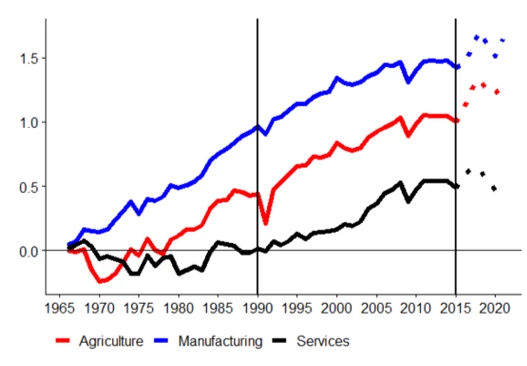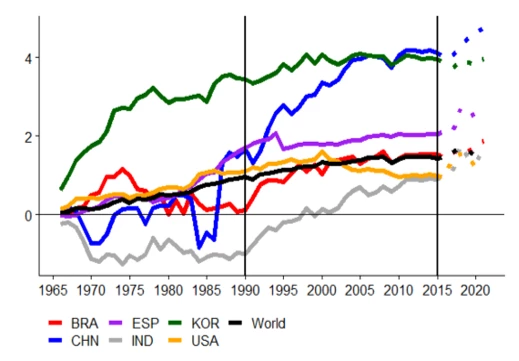 3D rendering Network and data exchange over planet earth in space. Connection lines Around Earth Globe. Global International Connectivity, Elements of this image furnished by NASA
3D rendering Network and data exchange over planet earth in space. Connection lines Around Earth Globe. Global International Connectivity, Elements of this image furnished by NASA
The debate is raging: Is globalization in retreat or not? If yes, to what extent, and what are the implications for global prosperity and poverty reduction? These aren’t easy questions to answer, largely because there are different definitions of globalization, which give rise to different ways of measuring it. Recent research at the World Bank, based on a new definition, suggests that globalization is alive and well.
But first, some context. For more than 50 years, globalization has been a catalyst for economic development, trade integration, and prosperity building. It has helped lift more than 1 billion people out of poverty. Since the 1990s, it has become a pathway for businesses in emerging economies to enter global value chains and nearly double their share of exports. Breathtaking advances in communications, transportation, and information technology have made it easier and cheaper for countries on opposite sides of the world to transact business, tap into each other’s markets, and share resources, knowhow, and technology. On the other hand, some critics in advanced economies blame globalization for the loss of manufacturing jobs, and others point to it as a source of greenhouse gas emissions.
Recently, the COVID-19 pandemic, the war in Ukraine, and China-US tensions have led countries and companies to rethink global strategies. But to what extent is globalization actually retreating? Some studies find little systematic evidence that it is, while others conclude that “trade openness” has recently fallen in some regions, coinciding with a slower pace of trade reforms and posing a threat to growth. This isn’t just an academic exercise. Accurately measuring globalization is necessary to understand the impact of the current challenges on the world economy. Economic policy cannot risk either overestimating deglobalization or underestimating the costs of such a scenario. For this reason, we need a clear definition with precise empirical applications that can guide economic policy.
The trade-to-GDP ratio — which calculates the relative importance of a country’s imports and exports to its economy — is one way to measure “openness” to trade . This ratio steadily rose until 2008, then suffered a sudden drop in 2009 following the global financial crisis. By 2011 it had recovered, but it lacked the same vigor as before the crisis, suggesting to some that globalization was waning.
Some economists continue to the use trade-to-GDP ratio as a measure of openness, although many others argue that it is an inadequate yardstick and doesn’t necessarily imply that high trade barriers exist. Instead, it could reflect factors such as the size or structure of the economy or its geographic proximity to trading partners.
So globalization is better understood as an extension beyond national borders of the same market forces operating at all levels of economic activity. Using this definition, we measured the intensity of globalization as the growth of international trade relative to domestic trade. For instance, automakers sell some cars in the domestic market and export the rest. Comparing the evolution of the exports of cars with domestic sales offers a better measure of globalization dynamics than the trade-to-GDP ratio. The model used to capture the relative dynamics of international and domestic trade is what economists call a structural gravity model. It allows for comparisons across countries and over time, capturing more intuitive globalization dynamics than the trade-to-GDP ratio. Among other factors, the reduction in trade barriers and advances in information technology make international trade grow faster than domestic trade, with the world becoming more globalized and with greater economic connectivity and cooperation among countries.
Based on this research, there is no evidence that the world economy has entered an era of deglobalization. China’s trade-to-GDP ratio, for example, has trended downward since 2006 and is now below both the world average and the level in 2001, when China entered the World Trade Organization. Yet even considering recent trade tensions with the United States, it would be difficult to argue that the Chinese economy is drastically less “open,” as the trade-to-GDP ratio would suggest. A better explanation is that trade has become less important to China’s GDP as its domestic economy has boomed.
A globalization analysis consistent with economic theory requires the study of sector-specific dynamics. For instance, manufacturing has traditionally been a more trade-intensive sector, but information and communication technology (ICT) advances seem to be making services more tradable, pointing to more globalization opportunities in the future. Figure 1 plots the main results of our research. It shows that globalization dynamics in manufacturing were already strong in 1965, while agriculture and services “took off” in the late 1970s and 1990s, respectively. There is no sign of a deglobalization trend post-2008.
Figure 1. Globalization took off at various times, depending on the sector and country.


Figure 1 (b) investigates manufacturing dynamics across countries. These results uncover differing dynamics, situating China as a globalization leader starting in the 1980s, outperforming the world economy significantly during the entire period. This story is different from the one told by the trade-to-GDP ratio. Other results also offer deep insights by illustrating how countries like India, while lagging in manufacturing globalization, have outperformed the world economy in services.
The debate on globalization uses various terms -- slowbalization, deglobalization, reglobalization. Each tells a very different story about changes in the world economy. Our research contributes to these debates by offering a globalization toolkit to understand where the world economy stands today and helping us to prepare for future dynamics.


Join the Conversation